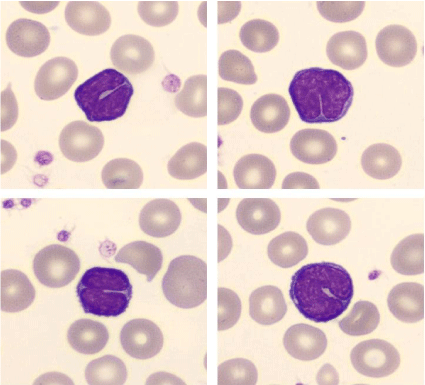
Special Article - Infectious Diseases
J Pediatr & Child Health Care. 2018; 3(1): 1021.
Utility of Peripheral Smear in Rapid Diagnosis of Pertussis
Di Matola T¹, Ciro M¹, Coppola M², Fumi M², Pancione Y², G Rummo Benevento²*, Sale S¹, Atripaldi L² and Rocco V²
¹AORN Hospital Dei Colli, UOC Clinical Biochemistry, Italy
²AORN G. Rummo Benevento, UO Clinical Pathology, Italy
*Corresponding author: G. Rummo Benevento, AORN G. Rummo Benevento, UO Clinical Pathology, Italy
Received: August 10, 2018; Accepted: August 20, 2018; Published: August 27, 2018
Clinical Image
A 1 month- old girl with no prior illness, presented to the emergency department for cough and shortness of breath. The blood analysis revealed an increased peripheral white blood cell count with lymphocytosis: WBC: 28,19* 109/L (75% lymphocytes, 21% neutrophils, 2,7% monocytes, 0,4% eosinophils and 0,2% basophils); hemoglobin level was 10,8 g/dL and platelet count was 518*109/L. Biochemistry was normal including normal C - reactive protein. Because of the leukocytosis and lymphocytosis, on the bases of the rules set to morphological evaluation with Cellavision system, a peripheral blood smear was automatically performed. Morphologic evaluation of the peripheral blood smear revealed numerous mature lymphocytes with scant cytoplasm, condensed chromatin, and clefted nuclei, characteristic of Bordetella pertussis lymphocytosis. On the basis of these findings and then of this clinical suspicion, a real time PCR was performed on a respiratory sample that was positive for B pertussis and Rhinovirus. The patient was treated with azithromycin and cortisone showing a progressive clinical improvement. Pertussis, an acute illness of respiratory and infants in pre-vaccination age are the most vulnerable group with the highest rates of morbidity and mortality. The clinical presentation can be atypical and the disease is often misdiagnosed. Analyzing culture is the gold standard for diagnosis but this takes a few days. Polymerase chain reaction is a rapid and more sensitive test but it is not available in all hospitals. Studies of pertussis in children show absolute lymphocytosis in >50% of patients, and characteristic small, mature lymphocytes with hyperchromatic, cleaved nuclei may account for as much as 56% of total lymphocytes. Therefore the presence of these lymphocytes can provide a strong diagnostic suspicion. This case emphasizes the utility of peripheral blood smear evaluation as a diagnostic tool until other results become available or when more sophisticated diagnostic methods are not available.

Figure 1: Small mature lymphocytes with deep nuclear clefts, characteristic
of Bordetella pertussis in-fection. Giesma stain of peripheral blood smear
(x1000).